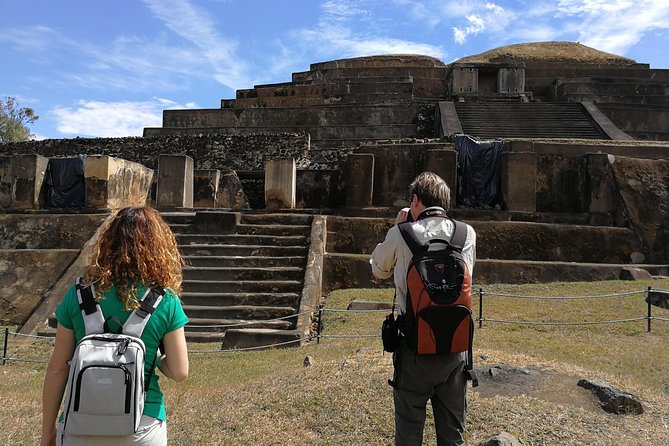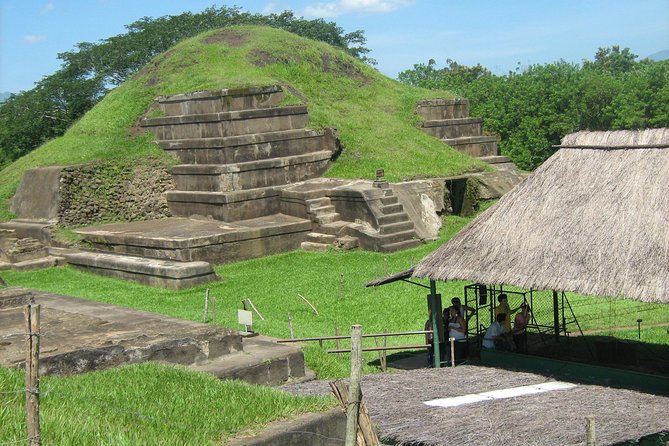Nestled in the heart of Central America, El Salvador boasts a treasure trove of ancient Maya ruins that captivate visitors from around the world. From the remarkably well-preserved site of Joya de Cerén, often dubbed the "Pompeii of the Americas," to the impressive structures and intricate carvings of San Andrés and Tazumal, these archaeological wonders offer a glimpse into the daily lives and architectural prowess of the Maya civilization. Complementing this rich cultural heritage, the charming town of Chalchuapa and the serene beauty of Coatepeque Lake create an immersive experience that transports travelers back in time. What secrets do these remarkable sites hold, and how do they reveal the enduring legacy of the Maya people?
Key Points
- El Salvador contains the southernmost remnants of the Ancient Maya Civilization, with key sites like Joya de Cerén, San Andrés, Tazumal, and Chalchuapa.
- Joya de Cerén, the "Pompeii of the Americas," offers a unique glimpse into the daily lives of Mayan villagers over 1,500 years ago, preserved by volcanic ash.
- San Andrés Ruins feature a well-preserved acropolis, temple-pyramid, and residential structures, showcasing the rich Mayan heritage in El Salvador.
- Tazumal Ruins, the largest Mayan site in El Salvador, showcase the architectural prowess and cultural sophistication of the Mayans through towering pyramids and intricate carvings.
- Chalchuapa Town offers a balance of Mayan heritage and Spanish colonial architecture, with traditional markets, handcrafted textiles, and the scenic Coatepeque Lake.
Overview of Maya Ruins
El Salvador hosts the southernmost remnants of the Ancient Maya Civilization, a captivating society that once flourished throughout parts of Central America.
Key sites like Joya de Cerén, San Andrés, Tazumal, and Chalchuapa dot the lush landscapes, offering visitors a chance to enjoy the rich Mayan heritage.
Joya de Cerén, a UNESCO World Heritage site, is known as the "Pompeii of the Americas" due to its preservation by volcanic ash, providing insights into the daily lives of Mayan villagers over 1,500 years ago.
Other notable ruins showcase ancient structures, intricate carvings, and sacred plazas that shed light on the sophistication of this ancient civilization.
You can also read our reviews of more tours and experiences in San Salvador.
Highlights of Joya De Cerén

Joya de Cerén, a UNESCO World Heritage site, offers a captivating glimpse into the daily lives of the ancient Maya.
Preserved under layers of volcanic ash, this remarkable site has been dubbed the "Pompeii of the Americas." Visitors can explore the remarkably well-preserved remains of a 6th-century Mayan farming village, including homes, workshops, and communal spaces.
The artifact-rich ruins provide invaluable insights into the agricultural practices, social structures, and religious beliefs of the Mayan people.
Wandering through the excavated structures, one can almost feel the vibrant pulse of this ancient community, frozen in time by the fateful volcanic eruption centuries ago.
Exploring San Andrés Ruins

The San Andrés Ruins stand as a captivating testament to the rich Mayan heritage of El Salvador. Visitors can explore the ancient structures, intricate carvings, and sacred plazas that offer a window into the daily lives of the Mayan people. The site features a well-preserved acropolis, a temple-pyramid, and a series of residential structures, all of which showcase the architectural and engineering prowess of the Mayan civilization. The following table provides a closer look at the key highlights and features of the San Andrés Ruins:
| Feature | Description |
|---|---|
| Acropolis | A large, elevated platform that served as the political and religious center of the site. |
| Temple-Pyramid | A towering structure that was used for religious ceremonies and rituals. |
| Residential Structures | Preserved dwellings that offer insights into the domestic lives of Mayan villagers. |
| Intricate Carvings | Detailed stone carvings and inscriptions that provide historical and cultural information. |
Discovering Tazumal Ruins
Towering over the landscape, the Tazumal Ruins command attention as the largest Mayan site in El Salvador. This archaeological treasure provides an immersive historical experience, allowing visitors to step back in time and explore the grandeur of ancient Mayan civilization.
Visitors can wander through the towering pyramids, admire the intricate carvings, and imagine the vibrant ceremonial activities that once took place in the sacred plazas. The site’s sheer size and well-preserved structures offer a glimpse into the architectural prowess and cultural sophistication of the Mayans who called this place home centuries ago.
Exploring Tazumal Ruins is a must for anyone seeking to uncover the secrets of El Salvador’s remarkable Mayan heritage.
Visiting Chalchuapa Town
Chalchuapa, a colonial town, serves as a scenic backdrop during the captivating tour of El Salvador’s Mayan ruins. Visitors can explore the town’s well-preserved Spanish colonial architecture, including its charming plazas and historic churches.
The town’s cultural heritage is also showcased through its traditional markets, where artisans sell handcrafted textiles, pottery, and other local goods. Chalchuapa’s vibrant energy and friendly locals add to the overall enchantment of the Mayan ruins experience.
Highlights of the town include:
- Plaza Barrios, the central square
- Church of Santiago Apostol, a 17th-century landmark
- Traditional markets selling handmade crafts
- Local cuisine, such as pupusas and horchata
- Scenic views of the surrounding volcanic landscapes
- Best Day-Tour : Santa Ana Volcano Hiking + Lake Coatepeque
- Full Day Route of the Flowers Visit Four Colonial Towns and Coffee Farm
- The Best Full Day Combo Tour – Volcanoes, Lake & Mayan Sites
- The Best of San Salvador in 1 Day: El Boqueron + Rainbow Slide + Historic Center
- Route of the Flowers: Hot Springs + Coffee Tour + Nahuizalco and Ataco Towns
- Ruta De Las Flores Adventure, Relax at Hotsprings + 1930S Farm Coffee Tour
Relaxing at Coatepeque Lake
After exploring the colonial charm of Chalchuapa, the tour moves on to a scenic stop at Coatepeque Lake. This picturesque volcanic lake offers a tranquil respite from the previous Mayan ruins. Visitors can admire the stunning vistas, surrounded by lush vegetation and the serene waters. While lunch is not included, the lake provides an opportunity to relax, take in the natural beauty, and perhaps even spot some local wildlife. The clear, blue waters and verdant landscapes make Coatepeque Lake a refreshing addition to the Maya ruins tour, allowing travelers to fully enjoy El Salvador’s diverse landscapes.
| Feature | Description |
|---|---|
| Location | Scenic volcanic lake |
| Activities | Admiring views, relaxing, potential wildlife spotting |
| Lunch | Not included in tour package |
| Experience | Tranquil respite from Mayan ruins |
Tour Inclusions and Accessibility
Typically, the Maya ruins tour includes a professional guide to lead the journey and provide in-depth commentary on the historical sites.
The tour package also covers hotel pickup and drop-off, as well as admission tickets to the various ruins.
While the tour isn’t wheelchair accessible, it’s stroller-friendly, allowing families with young children to explore the sites comfortably. Infants must be held on laps during the tour.
The overall experience is highly recommended, with 92% of travelers endorsing the tour.
However, it’s essential to communicate effectively with the tour operator to ensure a smooth and enjoyable experience.
- Professional guide
- Hotel pickup and drop-off
- Admission tickets
- Stroller-friendly
- Not wheelchair accessible
Customer Experiences and Feedback
According to the reviews, the majority of travelers found the Maya ruins tour in El Salvador to be an enriching and safe experience.
Many praised the knowledgeable guides who provided informative and engaging tours of the historical sites. Travelers were captivated by the beauty of the preserved ruins, such as Joya de Cerén, and the stunning natural landscapes, including Coatepeque Lake.
However, one review mentioned a no-show issue with the tour operator, highlighting the importance of clear communication and reliable service.
Frequently Asked Questions
Can I Bring My Own Food and Drinks on the Tour?
The tour allows participants to bring their own food and drinks, though lunch is not included in the tour price. Visitors are advised to pack snacks and beverages to enjoy during the various stops along the tour.
Is It Possible to Visit the Ruins at My Own Pace?
The tour provides a structured itinerary, but visitors can explore the ruins at their own pace within the allocated time frames. However, it’s essential to remain with the group and follow the guide’s instructions for the best experience.
Are the Guides Fluent in English and Other Languages?
The tour guides are fluent in English and other languages, allowing them to provide informative and engaging explanations of the Maya ruins to visitors from diverse backgrounds.
Can I Customize the Itinerary to Suit My Interests?
The tour’s itinerary can be customized to suit the traveler’s interests, within the tour’s scope and duration. Guests can discuss their preferences with the knowledgeable guides to ensure an optimal experience exploring the Mayan heritage sites.
Are There Any Additional Fees or Charges I Should Be Aware Of?
The tour includes all admission fees and hotel pickup/drop-off, but there may be additional costs for optional activities like lunch at Lake Coatepeque. It’s best to check with the tour operator for any supplementary charges.
Recap
The Maya ruins in El Salvador offer a captivating window into the region’s ancient past. From the well-preserved Joya de Cerén to the impressive structures at San Andrés and Tazumal, visitors can explore the architectural sophistication and daily life of this remarkable civilization. Complemented by the charming town of Chalchuapa and the serene Coatepeque Lake, this cultural heritage site provides a truly enriching experience for all who venture there.
More Tour Reviews in San Salvador
- Day at Exclusive Club Costa Del Sol Beach From San Salvador or Airport
- Golfo De Fonseca Tour | Day Experience
- Izalco Volcano Hiking ( Private Tour ) + Lake Coatepeque
- El Salvador: The Peace Route Tour
- Private 4×4 Tour With View of San Salvador From the Former Cable Car
- 6-Day Best of West El Salvador : Cerro Verde, Coffe Route, Maya Ruins
Not for you? Here's more things to do in San Salvador we have recnetly reviewed
- Best Cruises And Boat Tours In San Salvador
- 3 Best Shopping Tours In San Salvador
- 4 Best Full-Day Tours In San Salvador
- 7 Best Coffee Tours And Tastings In San Salvador
- 3 Best Lunch Experiences In San Salvador
- Santa Ana Volcano Hike+ Coatepeque Lake
- Surf City
- San Miguel ( Chaparastique ) Epic Hiking Volcano
- Transportation to PLAYA MIZATA and PLAYA DORADA From the Airport
- Transportation to El Boqueron National Park, San Salvador Volcano
- Conchagua Volcano Overnight + Boat Ride & Lunch at Golfo De Fonseca
- From San Salvador to La Libertad Beaches
